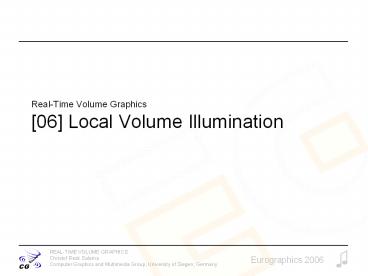Real-Time Volume Graphics [06] Local Volume Illumination - PowerPoint PPT Presentation
Title:
Real-Time Volume Graphics [06] Local Volume Illumination
Description:
Title: Real Time Volume Graphics Subject: SIGGRAPH 2004 Course Notes Author: Christof Rezk Salama Keywords: Computer Graphics, Volume Rendering, Visualization – PowerPoint PPT presentation
Number of Views:112
Avg rating:3.0/5.0
Title: Real-Time Volume Graphics [06] Local Volume Illumination
1
Real-Time Volume Graphics06 Local Volume
Illumination
2
Volume Illumination
- Up until now Light was emitted by the volume
- Now Illumination from external light sources
Types of Volume Illumination
- Single scattering with attenuation.
- Light is attenuated along ist way through
the volume (Volumetric shadows) - Light is scattered once before it reaches
the eye
- Multiple scattering
- Light is scattered multiple times before it
reaches the eye (Global illumination)
- Single scattering, no attenuation.
- Light reaches every point unimpededly
- Light is scattered once before it reaches
the eye - Not physically plausible
3
Single Scattering
- Local illumination, similar to surface lighting
- Lambertian reflection(light is reflected equally
in all directions) - Perfect mirror reflection(light is reflected in
exactly one direction) - Specular reflection(light is reflected scattered
around the direction of perfect reflection)
4
Blinn/Phong Illumination
- Diffuse Term (Lambertian reflection)
n
l
5
Phong Illumination
- Specular Term (view-dependent)
n
r
l
v
6
Blinn/Phong Illumination
Phong Illumination
- Specular Term (view-dependent)
n
h
l
v
7
Blinn/Phong Illumination
- Ambient Term (constant illumination)lightens
up the shadows, also decreases the contrast!
Example images taken from Jeremy Birn Digital
Lighting Rendering,New Riders Publishing, 2000
8
Local Illumination
- Surface lighting Light is reflected at surfaces
- Volume lighting Light is scattered at isosurfaces
- Isosurface extraction not required!
- We only need the normal vector
- Normal vector of isosurface is equal to
(normalized) gradient vector
9
Gradient Estimation
- The gradient vector is the first-order derivative
of the scalar field - We can estimate the gradient vector using finite
differencing schemes
partial derivativein x-direction
partial derivativein y-direction
partial derivativein z-direction
10
Finite Differences
- Taylor expansion
Forward Difference
Backward Difference
11
Finite Differences
Central Difference
Gradient Approximation using Central Differences
12
Pre-computed Gradients
- Calculate the gradient for each voxel
- Store the normalized gradient in an additional
texture.
Example Use an RGBA texture
Example Use an RGB texture
13
Basic Idea of Ray-casting Pipeline
- Data are defined at the corners
- of each cell (voxel)
- The data value inside the
- voxel is determined using
- interpolation (e.g. tri-linear)
- Composite colors and opacities
- along the ray path
- Can use other ray-traversal schemes as well
c1
c2
c3
14
Ray Traversal Schemes
Intensity
Max
Average
Accumulate
First
Depth
15
Ray Traversal - First
Intensity
First
Depth
- First extracts iso-surfaces (again!)done by
TuyTuy 84
16
Ray Traversal - Average
Intensity
Average
Depth
- Average produces basically an X-ray picture
17
Ray Traversal - MIP
Intensity
Max
Depth
- Max Maximum Intensity Projectionused for
Magnetic Resonance Angiogram
18
Ray Traversal - Accumulate
Intensity
Accumulate
Depth
- Accumulate opacity while compositing colors make
transparent layers visible!Levoy 88
19
Raycasting
volumetric compositing
color
opacity
object (color, opacity)
20
Raycasting
Interpolationkernel
volumetric compositing
color
opacity
1.0
object (color, opacity)
21
Raycasting
Interpolationkernel
volumetric compositing
color c c s ?s(1 - ?) c
opacity ? ? s (1 - ?) ?
object (color, opacity)
22
Raycasting
volumetric compositing
color
opacity
1.0
object (color, opacity)
23
Raycasting
volumetric compositing
color
opacity
1.0
object (color, opacity)
24
Raycasting
volumetric compositing
color
opacity
1.0
object (color, opacity)
25
Raycasting
volumetric compositing
color
opacity
1.0
object (color, opacity)
26
Raycasting
volumetric compositing
color
opacity
object (color, opacity)
27
Brute-Force Algorithm
28
Volume Rendering Pipeline
Acquired values
Data preparation
Prepared values
classification
shading
Voxel colors
Voxel opacities
Ray-tracing / resampling
Ray-tracing / resampling
Sample colors
Sample opacities
compositing
Image Pixels





























![Real-Time Volume Graphics [07] Global Volume Illumination PowerPoint PPT Presentation](https://s3.amazonaws.com/images.powershow.com/7513877.th0.jpg?_=20160105118)
![Real-Time Volume Graphics [02] GPU Programming PowerPoint PPT Presentation](https://s3.amazonaws.com/images.powershow.com/8453804.th0.jpg?_=20170201075)
